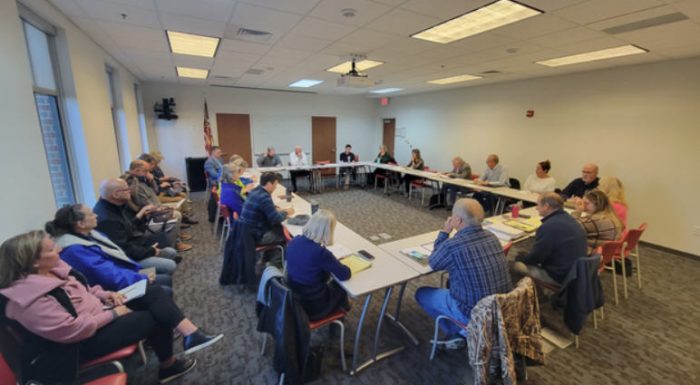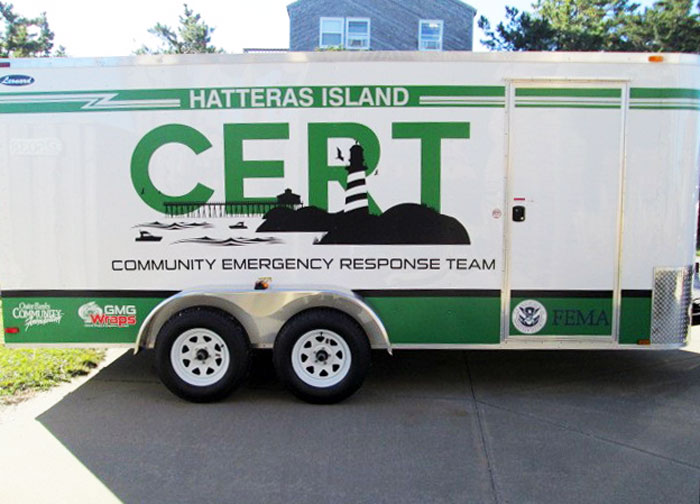Dare Housing Task Force establishes mission statement, discuss ‘target market’

From SamWalkerOBXNews.com
After being canceled in February due to the funeral of Ray White, the Dare County Housing Task Force held its second meeting on Tuesday at the Dare Government Center in Manteo.
One of the main accomplishments of the meeting was the establishment of a mission statement for the 26-member panel:
To collaboratively develop short-term and long-term solutions to address housing issues affecting Dare County residents, business owners and workforce. These solutions include identifying physical sites for the construction of housing units, building community support through appropriate outreach activities, and implementing regulatory reforms and options that can be tailored to fit each community’s unique characteristics and constituency.
Among other topics discussed at the nearly 2-hour long meeting included trying to determine if the group will be narrow-focusing on a specific “target market”, and deeper explanations of why there are restrictions on the use of public funds that make it more difficult to meet the county’s need for housing.
Scroll through the live blog below from SamWalkerOBXNews.com for further details.
9:10 a.m.
Dare County Board of Commissioners Chairman Bob Woodard noted at opening the meeting that were several members of the task force not in attendance due to the Outer Banks Chamber of Commerce holding its annual Economic Forum at the same time in Kill Devil Hills.
Woodard said he felt it would not be productive to cancel this month’s meeting as well, and appreciated stand-in representatives attending for members that had to be at the forum.
Dare County Manager Bobby Outten informed the task force that an online Google Drive had been created to ease the sharing of meeting minutes and other documents amongst the members.
The floor was opened to discuss a mission statement for the task force.
Outer Banks Association of Realtors Government Affairs Director Donna Creef read the initial draft of the statement, which was adopted without further discussion.
9:30 a.m.
Moving on in the agenda to establishing a “Target Market”, Outten notes that there are certain limits that the county and town governments have to follow.
“There’s a broad spectrum of housing needs or housing request or housing discussions…how we’re going to phrase it and the question becomes what is our target market,” Outten said. “And then how can we address that target market…that’s gonna play into understanding housing authorities and stuff like that, when it comes to that.”
“That target market can be narrow or can be broad; The players’ portable housing game changes based on who the market is,” Outten said.
Outten said that while entities like the Dare County Schools or Outer Banks Health have more options if they choose to provide housing, the towns and county have constitutional limits on how they could construction a housing complex.
He says that local governments using public money for housing would have to provide a certain percentage of housing to low-income residents.
There have been legal challenges to the amount of housing that has to be set aside for low income, and also the percentage of income that qualifies as low income.
In most cases, that number has been around 80% of the area’s median income level.
Discussions about the pay scale for teachers, healthcare providers, local government workers, and private business employees impact the pool of workers that is available, and that some would and some wouldn’t qualify under 80% AMI.
10:05 a.m.
Malcolm Fearing said that Dare County doesn’t have a housing inventory problem, but rather a problem of available housing for workers.
He believes that the target market needs to be “everything”.
Kill Devil Hills Town Commissioner Ivy Ingram says this is not just trying to solve an immediate issue, but also 10 to 20 years down the road.
Ingram said as those who are in positions across a broad range of entities are going to be retiring, which is just going to compound the issue of not only available inventory of housing, but also having residents of a younger age to fill those roles.
Mitchell Bateman of Wanchese points out that the largest employer in Dare County is the school system, and the Dare Education Foundation has units in Kill Devil Hills and Buxton for teachers to live in for up to 4 years at an affordable rate compared to privately owned housing elsewhere.
By using a 501c3 nonprofit, they were able to access funding. Bateman asks can a nonprofit be formed to access the county money.
Outten said the money the county has access to would still be restricted by the 80% AMI limits, even as a grant writer to a nonprofit or the community at large.
As part of the Target Market discussion, it is brought up again that 3,000 units are what’s been found as the amount needed to address the needs in Dare County.
But there isn’t enough useable land to meet that number because of a number of factors, including local opposition.
Tess Judge asks if there is a time limit for the county to spend its $35 million allocation, and Chairman Woodard says no. But the General Assembly could very well pull it back if they see its not going to end up being spent sooner rather than later.
Woodard asks the task force to continue its discussions ahead of the next meeting on identifying the target market.
11:15 a.m.
Outten is now explaining that establishing a Housing Authority would again trigger limits on income levels, and that the restrictions on housing projects were also discussed earlier in the meeting.
Going around the room now…
Steve Basnight: Despite having the housing at Run Hill and Buxton, they still have a waiting list for their staff that wants. He said they lost at least 3 teachers this year because their 4-year lease window was up, and that going to a 5-year lease would just “stretch the Band-Aid”.
Southern Shores Mayor Elizabeth Morey: 300 units is not going to get us out of this problem, asks what can be done in Raleigh to get the authority needed to get more units out of the short-term market and into long-term rentals. Woodard adds there needs to be financial incentives. Outten said getting someone from the UNC School of Government or elsewhere to talk to the task force about what’s being done around the country, and possibly create a “menu” of choices.
Carol Warnecki, private citizen representing the north beach: Educating the public is key, because there is quite a bit of misinformation out there about the solutions and what the $35 million can do.
Malcolm Fearing: Regulatory reform at the local level, along with finding a way to use the land resources the county and state has to possibly get around the income limits that are placed on allocations from the government.
Caroline Basnight, representing the hospitality and business community: She agrees with Tess Judge on how this is impacting their side of the equation, and notes that while some would meet the income thresholds that work in their industry, others will not. She also points out how many work at their restaurant that are second jobs, including teachers and staff at the schools.
Dare County Board of Education member Ron Payne: Starting to narrow down the focus of who the housing is for, but still have to overcome the “not in my backyard” opponents who still don’t understand who this housing initiative is for.
Duke Geraghty of the Outer Banks Home Builders Association: Says a bill that would allow multi-family units to be built on essentially any size lot stalled in the General Assembly, and probably will stall again. He also mentions the NIMBYs, and government regulations such as larger minimum lot sizes that are up for review in certain parts of Currituck are going to be further obstacles.
Donna Creef of the Outer Banks Association of Realtors: Getting creative with several sides of the equation, including finding a way to not so much restrict short-term rentals but limit them, since so many homeowners that live here are using part of their home as a second source of income to be able to afford to live here. She notes the positive discussions taking place around the table are making progress.
Ivy Ingram, Kill Devil Hills Town Commissioner: They just approved a cluster-home development behind Walgreens that will have a minimum 90-day covenant, talks about also consider establishing residential-only zones in other resort communities. Ryan Lang, Senior Planner for KDH, adds the addition of ADUs on the westside.
The floor was opened to comments from the audience.
Incoming Dare County Commissioner Carson Creef polls the room and notes that there isn’t the space to build these homes, and that finding transportation and other out-of-the-box solutions needs to be done.
A comment agreed on by many in the room was that an easy sign of a church failing is the lack of young people attending, and that young people not being able to find housing in Dare County will lead to failure.
Dare County commissioner candidate Katie Morgan said maybe giving back the $35 million to the state, while getting creative with the $12 million the county has set aside, should be considered. She feels that if there is a time crunch tied to that money, that just finding a short-term solution that has larger negatives down the road is a concern.
Others shared personal anecdotes about their own experiences in struggling to find housing, or observations they’ve made about similar communities and how they have found workable solutions such as mixed-use developments.
The meeting has adjourned, with the next gathering of the Task Force scheduled for April 16 at 9 a.m.














“Southern Shores Mayor Elizabeth Morey: 300 units is not going to get us out of this problem, asks what can be done in Raleigh to get the authority needed to get more units out of the short-term market and into long-term rentals.” There is nothing scarier than a politician even thinking about restricting property usage. Short-term rentals generate levels of revenue that long-term ones will never see especially given the fact that the people using them do not have enough income to purchase or lease housing. If you cannot afford a market priced home then you cannot afford a market priced rental. Eviction has always been a problem and that alone is a reason to not have a long-term rental. Mission statements and glad-handing will not solve anything. The reality is the best of use of any property within a mile of the ocean or sound is as a short-term rental. The housing needs to be on the mainland if it is to be done. I am glad someone realizes 3000 units is not a possibility and even getting to a third of that is most likely possible with local opposition and I know the local government meetings will be watched a lot more carefully for attempts to change land use rules.